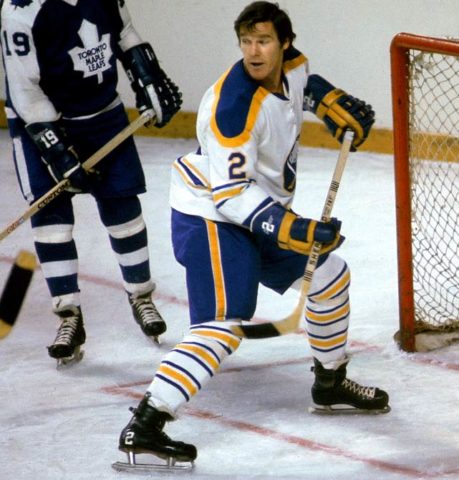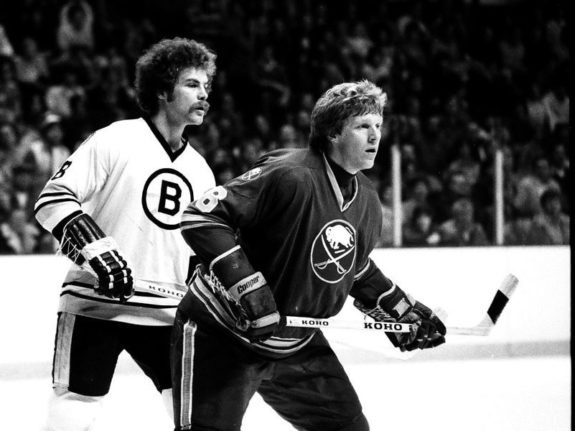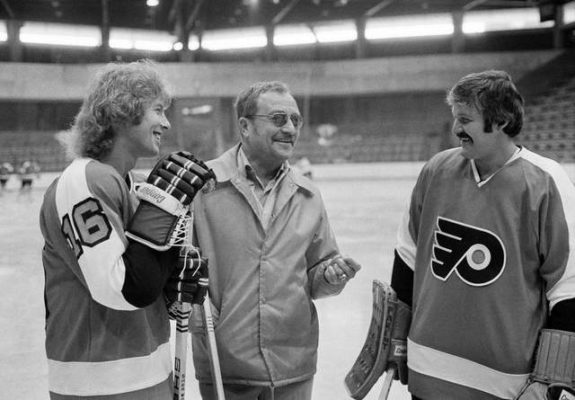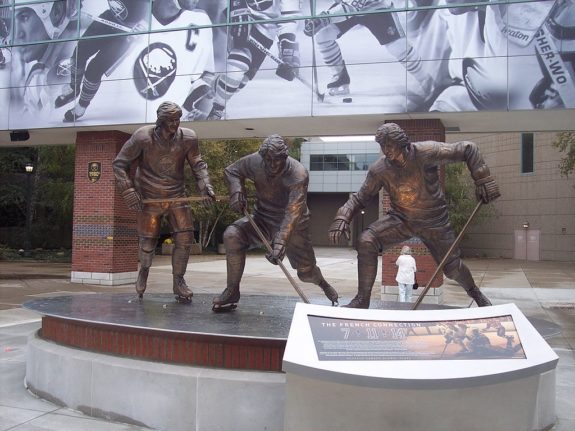Everyone remembers their first experience of heartbreak and how tough it was to get over it. It’s no different in professional sports. Every fan of every sports team can vividly recall what it was like to have their hopes dashed for the very first time and just how disappointing it was.
For the Buffalo Sabres, it was the 1975 Stanley Cup Final. Despite being less than five seasons old at the time, the young franchise shocked the hockey world by advancing all the way to its first championship series in just its second postseason appearance. It was a remarkable run for the Sabres, even if it did end in the bitter taste of defeat.
In addition to being a truly great series, the 1975 Stanley Cup Final was historic in numerous other ways. As we continue to look at the toughest and most notable losses in Sabres history, we jump back in time nearly half a century. To the Disco Decade, we go.
1974-75 Was Buffalo’s Breakout
The Sabres were only four seasons old as the 1974-75 NHL season began, and the team was still very much finding its footing at the time. Despite qualifying for the playoffs for the first time in the 1972-73 season, they regressed in what was a very difficult 1973-74 season, a campaign that saw numerous injuries. Hockey eventually took a back seat to reality that February, however, when alternate captain Tim Horton was killed in a car accident in St. Catharines, ON while traveling home from a game in Toronto.

Though they were looking to rebound from such a tumultuous stretch, the Sabres had a tough summer, losing many key players to both the 1974 Expansion Draft and the rival World Hockey Association. Despite this, a key moment occurred at the 1974 NHL Entry Draft when the team selected future captain Danny Gare in the second round, a move that paid immediate dividends.
In an effort to spark his team, head coach Floyd Smith made quite the splash when he stripped Gerry Meehan of the team’s captaincy and awarded it to Jim Schoenfeld just three days ahead of his 22nd birthday. Such a move had never been seen before in hockey and made Schoenfeld the youngest captain in NHL history to that point. Meehan was traded to the Vancouver Canucks three games into the season in exchange for All-Star Jocelyn Guevremont.
After a slow start in October, the Sabres exploded in November, losing just one game the entire month and winning 10 in a row at one point. The momentum propelled them for the rest of the season, finishing with a 49-16-15 record and becoming the inaugural champion of the newly-created Adams Division of the Wales Conference.
Offense was the story of the year. The trio of Quebecois forwards Gilbert Perreault, Rick Martin and Rene Robert formed one of the most dangerous lines in the game and combined for 291 points on the season, despite the purported bad blood between Perreault and Martin before the season (from “Harmony makes Sabres winners”, The Ottawa Citizen, 10/11/1974). Don Luce, Rick Dudley and Jim Lorentz all registered 70 or more points while Gare had a fantastic rookie year with 31 goals.
The team was also strong defensively, anchored by Schoenfeld, Guevremont, Bill Hajt and Jerry “King Kong” Korab. Gary Bromley shouldered the weight of the team in goal in his first full NHL season, and while his stats weren’t fantastic (a 3.10 goals-against average and .893 save percentage), he played well enough to accrue a 26-11-11 record.

In all, the Sabres’ 113 points were tied for the best in the NHL, and the league’s new playoff format earned them a bye in the preliminary round. After defeating the Chicago Blackhawks in the Quarterfinals, they avenged their playoff loss from two years prior by defeating the Montreal Canadiens in the Semifinals.
In the span of one season, the Sabres had transformed from a fledging expansion franchise to a Stanley Cup finalist. And though that was a remarkable accomplishment in its own right, the most formidable team of the 1970s awaited them – the Philadelphia Flyers.
The 1975 Stanley Cup Was Historic Before It Started
Before the puck ever dropped in Game 1 of the 1975 Stanley Cup Final between the Flyers and the Sabres, the series was notable for numerous reasons. For starters, it was the first in NHL history contested by two non-Original Six teams, as the Flyers were only three seasons older than the Sabres, having joined in the 1967 Expansion. The Cup Final had been dominated by the league’s founding clubs to that point even after 1967. The St. Louis Blues became the first expansion franchise to reach it, losing three years in a row from 1968 to 1970.
The Flyers became the second expansion franchise to make it to the Stanley Cup Final and the first to win it in 1974. By qualifying in 1975, the Sabres became the first post-1967 team to appear. It was also the only one between the years 1965 and 1979 that didn’t feature either the Boston Bruins or the Montreal Canadiens, which puts into perspective the veritable monopoly the two teams had on the game at the time.
The Broad Street Bullies vs. The French Connection
The 1975 Stanley Cup was destined for greatness from the beginning, as it featured the NHL’s top two teams that season. The Flyers were the regular season champion of the Clarence Campbell Conference while the Sabres were their counterpart in the Prince of Wales. The teams finished with the same point total but the Flyers owned the best record in the game with two more wins, led on offense by captain Bobby Clarke and Bill Barber and in goal by Bernie Parent (all Hall of Famers).

The Flyers teams of the 1970s have become the stuff of legend in the annals of the NHL. Renowned for their skill, physicality and fearlessness, they earned the moniker “The Broad Street Bullies” for the road on which the Philadelphia Spectrum was located. Having taken down Bobby Orr and the Big Bad Bruins the previous season, the Flyers were the defending Stanley Cup Champions and stood a strong chance of repeating against the younger, less-experienced Sabres.
Related: Broad Street Bullies: More Than Goons, Fists & Enforcers
The Sabres were no pushover and possessed both the skill and toughness to back it up, but they were still the new team on the block looking to prove they belonged, and their inexperience was evident early. The team struggled in its first experience of hockey’s greatest spotlight and dropped the first two games at the Spectrum, scoring just one goal in each. However, neither team was prepared for what was awaiting them as the series shifted to Buffalo.
Hockey’s Most Bizarre Game Ever
Western New York was hit with an unusual early-season heat wave in the spring of 1975 and thermometers rose to summer-like levels on May 20 as both teams prepared for Game 3. The high temperature and humidity (reportedly 90 degrees and 62% respectively) overwhelmed the refrigeration system of Buffalo’s Memorial Auditorium, which wasn’t air-conditioned, and turned the building into a 16,000-seat sauna. As a result, a thick layer of vapor rose above the surface of the ice. Players and rink attendants skated around waving bed sheets in an attempt to make it dissipate, but the efforts proved futile and both teams were forced to accept the conditions.
Simply trying to see through a thick fog is difficult enough and the prospect of playing a contact sport in it is downright terrifying. It was a tough game for everyone involved, as the players struggled to see their teammates, commentators and fans alike struggled to follow the action, and play had to be stopped numerous times in an attempt to quite literally, clear the air. As if that wasn’t surreal enough, a bat came down from the arena’s rafters and flew around the ice until Jim Lorentz swatted it out of the air with his stick. The Flyers’ Rick MacLeish then picked it up and tossed it into the penalty box as if nothing had happened.
It was an understandably arduous contest for the goaltenders too, as the Sabres’ Gerry Desjardins was pulled after allowing three goals on six shots in the first period and was replaced by Roger Crozier (Bromley did not appear in the postseason for the Sabres despite starting over half of the team’s schedule). Crozier then turned aside 26 of the 27 shots he faced, allowing the Sabres to tie the game at four and force overtime.
The extra frame was a tense stalemate, as neither team could find a way to get one past the opposing netminder despite the poor visibility. With time running down and the prospect of double overtime looming, the Sabres’ top line stepped onto the ice. Robert picked up a dump-in from Perreault in the Flyers’ zone and slammed a shot from the corner that beat Parent through the legs (it appeared to catch him off-guard as he lost his balance and fell afterward). The Auditorium erupted as the Sabres poured onto the ice to celebrate their first-ever Stanley Cup Final victory.
It’s been 47 years since that game but it remains one of the most memorable moments in Sabres history and may have been what truly put the team on the map when considering its legacy in the NHL. It also made a legend of Robert and was revisited numerous times after he passed away in June 2021 (with Martin having passed in 2011, Perreault is the last surviving member of The French Connection).
Buffalo’s Remarkable Run Comes up Short
The fog did not return for Game 4, but the Sabres skated away with a 4-2 victory to knot the series at two. That was as close as they would get, however, as the Flyers took the next two to repeat as Stanley Cup Champions (they remain the only two titles the team has ever won). Parent’s excellence in goal proved too much for the Sabres to overcome and he won his second consecutive Conn Smythe Trophy as postseason MVP.
It was a sour and disappointing way for such an exceptional and unexpected ride to come to an end for the Sabres. It also was the first truly heartbreaking loss for fans of a franchise that has suffered more than a few in its history.

Still, the 1974-75 Sabres had nothing to be ashamed of when it was all said and done. In the span of one season, the franchise had shed its newcomer identity and morphed into a legitimate contender that opponents needed to treat with respect. And in only their second postseason appearance ever, they climbed the mountain and though they fell off before reaching the zenith, still took the fight to one of the greatest teams ever to take to the ice in the NHL. The Flyers had the more experienced and proven roster, and while that proved to be the difference maker in the end, the Sabres proved they were no joke that year and went on to make the playoffs in each of the next 10 seasons.
Buffalo embraced the Sabres from the very beginning, but it was during the 1974-75 season that hockey truly became a thing in Western New York. In that sense, it can be argued that this was the most important Sabres team ever, as they made believers of their still-growing fanbase. Though the loss will always sting for those that remember it, Sabres fans should be forever grateful for the 1974-75 team.